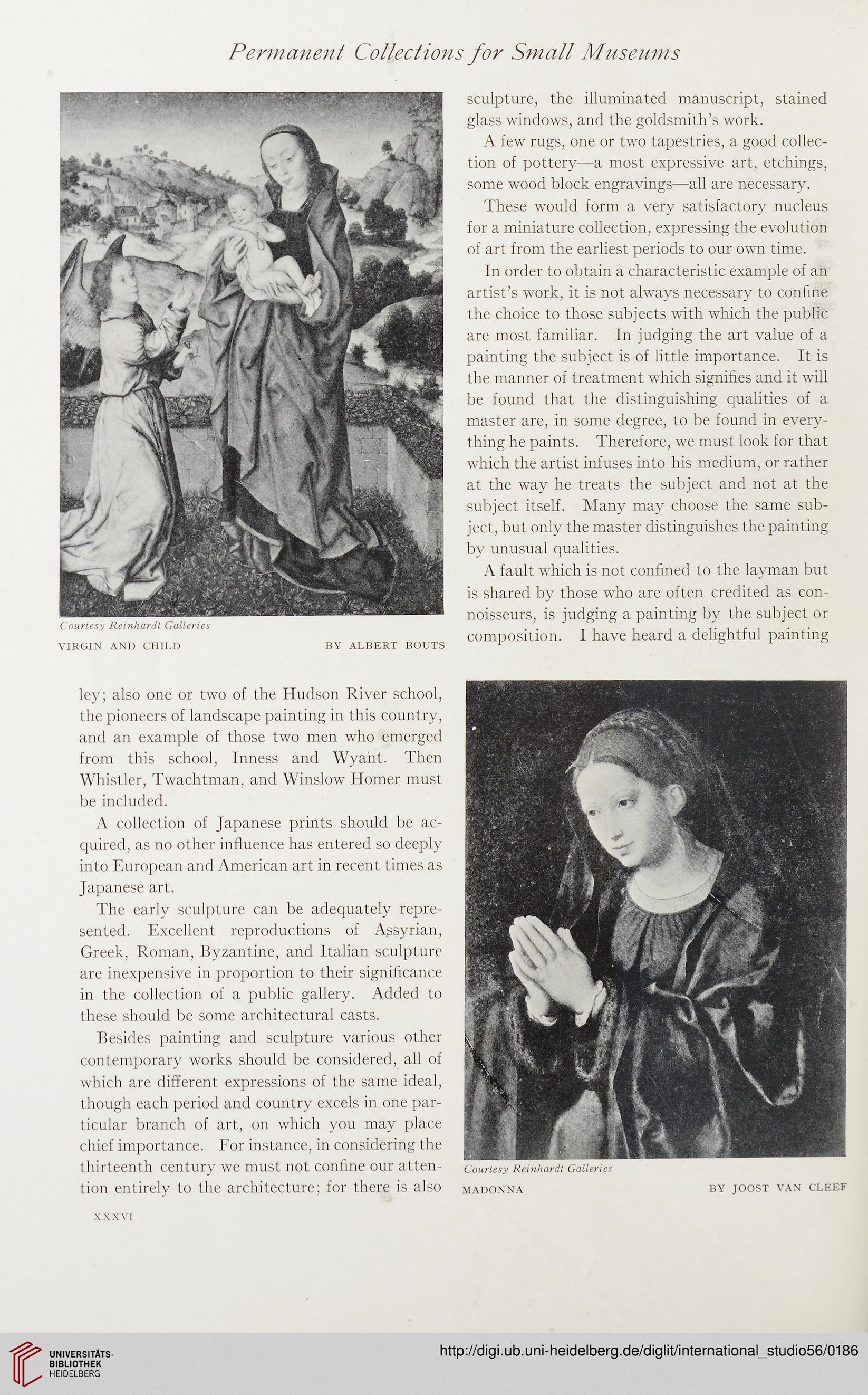Permanent Collections for Small Museums
Courtesy Reinhardt Galleries
VIRGIN AND CHILD BY ALBERT BOUTS
sculpture, the illuminated manuscript, stained
glass windows, and the goldsmith’s work.
A few rugs, one or two tapestries, a good collec-
tion of pottery—a most expressive art, etchings,
some wood block engravings—all are necessary.
These would form a very satisfactory nucleus
for a miniature collection, expressing the evolution
of art from the earliest periods to our own time.
In order to obtain a characteristic example of an
artist’s work, it is not always necessary to confine
the choice to those subjects with which the public
are most familiar. In judging the art value of a
painting the subject is of little importance. It is
the manner of treatment which signifies and it will
be found that the distinguishing qualities of a
master are, in some degree, to be found in every-
thing he paints. Therefore, we must look for that
which the artist infuses into his medium, or rather
at the way he treats the subject and not at the
subject itself. Many may choose the same sub-
ject, but only the master distinguishes the painting
by unusual qualities.
A fault which is not confined to the layman but
is shared by those who are often credited as con-
noisseurs, is judging a painting by the subject or
composition. I have heard a delightful painting
ley; also one or two of the Hudson River school,
the pioneers of landscape painting in this country,
and an example of those two men who emerged
from this school, Inness and Wyant. Then
Whistler, Twachtman, and Winslow Homer must
be included.
A collection of Japanese prints should be ac-
quired, as no other influence has entered so deeply
into European and American art in recent times as
Japanese art.
The early sculpture can be adequately repre-
sented. Excellent reproductions of Assyrian,
Greek, Roman, Byzantine, and Italian sculpture
are inexpensive in proportion to their significance
in the collection of a public gallery. Added to
these should be some architectural casts.
Besides painting and sculpture various other
contemporary works should be considered, all of
which are different expressions of the same ideal,
though each period and country excels in one par-
ticular branch of art, on which you may place
chief importance. For instance, in considering the
thirteenth century we must not confine our atten-
tion entirely to the architecture; for there is also
Courtesy Reinhardt Galleries
MADONNA BY JOOST VAN CLEEF
XXXVI
Courtesy Reinhardt Galleries
VIRGIN AND CHILD BY ALBERT BOUTS
sculpture, the illuminated manuscript, stained
glass windows, and the goldsmith’s work.
A few rugs, one or two tapestries, a good collec-
tion of pottery—a most expressive art, etchings,
some wood block engravings—all are necessary.
These would form a very satisfactory nucleus
for a miniature collection, expressing the evolution
of art from the earliest periods to our own time.
In order to obtain a characteristic example of an
artist’s work, it is not always necessary to confine
the choice to those subjects with which the public
are most familiar. In judging the art value of a
painting the subject is of little importance. It is
the manner of treatment which signifies and it will
be found that the distinguishing qualities of a
master are, in some degree, to be found in every-
thing he paints. Therefore, we must look for that
which the artist infuses into his medium, or rather
at the way he treats the subject and not at the
subject itself. Many may choose the same sub-
ject, but only the master distinguishes the painting
by unusual qualities.
A fault which is not confined to the layman but
is shared by those who are often credited as con-
noisseurs, is judging a painting by the subject or
composition. I have heard a delightful painting
ley; also one or two of the Hudson River school,
the pioneers of landscape painting in this country,
and an example of those two men who emerged
from this school, Inness and Wyant. Then
Whistler, Twachtman, and Winslow Homer must
be included.
A collection of Japanese prints should be ac-
quired, as no other influence has entered so deeply
into European and American art in recent times as
Japanese art.
The early sculpture can be adequately repre-
sented. Excellent reproductions of Assyrian,
Greek, Roman, Byzantine, and Italian sculpture
are inexpensive in proportion to their significance
in the collection of a public gallery. Added to
these should be some architectural casts.
Besides painting and sculpture various other
contemporary works should be considered, all of
which are different expressions of the same ideal,
though each period and country excels in one par-
ticular branch of art, on which you may place
chief importance. For instance, in considering the
thirteenth century we must not confine our atten-
tion entirely to the architecture; for there is also
Courtesy Reinhardt Galleries
MADONNA BY JOOST VAN CLEEF
XXXVI




